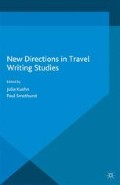Abstract
Critical approaches to travel writing have tended to overlook the mundane, everyday infrastructures at work in the background of mobile lives, from the roads and tunnels guiding human movement, to the networks of electric cables and pipelines channelling flows of energy and information. For many in the industrialized world, infrastructure has come to form a Lukácsian ‘second nature’ that remains invisible due to its sheer ubiquity; for this reason, the spaces and technologies that facilitate movement in travel narratives often go unnoticed.1
Access this chapter
Tax calculation will be finalised at checkout
Purchases are for personal use only
Preview
Unable to display preview. Download preview PDF.
Notes
Georg Lukács, Theory of the Novel: a Historico-Philosophical Essay on the Forms of Great Epic Literature (Cambridge, MA: MIT Press, 1971), 64.
Michael Rubenstein, Public Works: Infrastructure, Irish Modernism, and the Postcolonial (Notre Dame, IN: University of Notre Dame Press, 2010).
Nigel Thrift, ‘Movement-space: the changing domain of thinking resulting from the development of new kinds of spatial awareness’, Economy and Society 33.4 (Nov 2004): 584–5.
Bruce Robbins, ‘The Smell of Infrastructure: Notes toward an Archive’, boundary 234.1 (Spring 2007): 25–33
Bruce Robbins, ‘Infrastructure as Political Unconscious’, Minnesota Review 70 (Spring/Summer 2008): 207–13
Kate Marshall, Corridor: Media Architectures in American Fiction (Minneapolis: University of Minnesota Press, 2013).
John Uny, Mobilities (Cambridge: Polity, 2007), 13–14.
John Urry Sociology Beyond Societies: Mobilities for the Twenty-first Century (London: Routledge, 2000)
Mimi Sheller and John Uny, ‘The new mobilities paradigm’, Environment and Planning A 38.2 (2006): 207–26
Anthony Elliott and John Urry, Mobile Lives (New York: Routledge, 2010)
Tim Cresswell, ‘Towards a politics of mobility’, Environment and Plannind D: Society and Space 28.1 (2010): 17–31.
Bruno Latour, We Have Never Been Modern (Cambridge, MA: Harvard University Press, 1993), 117.
Michael Mann, The Sources of Social Power: Volume 1 (Cambridge: Cambridge University Press, 1986)
Paul Virilio, Negative Horizon (London: Continuum, 2006), 48.
Henri Lefebvre, ‘Space and the State’, State, Space, World (Minneapolis: University of Minnesota Press, 2009), 224.
Eric Swyngedouw and Maria Kaika, ‘Fetishizing the Modem City: The Phantasmagoria of Urban Technological Networks’, International Journal of Urban and Regional Research 24.1 (March 2000): 120–38.
Paul N. Edwards, ‘Infrastructure and Modernity: Force, Time, and Social Organization in the History of Sociotechnical Systems’, Modernity and Technology, eds. T.J. Misa, P. Brey, A. Feenberg (Cambridge, MA: MIT Press, 2003), 185–225
Martin Heidegger, ‘The Question Concerning Technology’, Basic Writings, ed. David Farrell Krell (San Francisco: Harper Collins, 1977), 318.
Maud Ellmann, The Nets of Modernism (Cambridge: Cambridge University Press, 2010), 2.
Matthew Beaumont and Michael Freeman, The Railway and Modernity: Time, Space, and The Machine Ensemble (Bern: Peter Lang, 2007), 35.
Paul Fussell, Abroad: British Literary Traveling between the Wars (Oxford: Oxford University Press, 1982).
Helen Can, ‘Modernism and Travel, 1880–1940’, The Cambridge Companion to Travel Writing, eds. Peter Hulme and Tim Youngs (Cambridge: Cambridge University Press, 2002), 70–86
David Farley, Modernist Travel Writing: Intellectuals Abroad (Columbia: University of Missouri Press, 2010).
D. H. Lawrence, Late Essays and Articles: Volume 2, ed. James T. Boulton (Cambridge: Cambridge University Press, 2004), 292.
Lawrence, Sea and Sardinia (Cambridge: Cambridge University Press, 1997), 30.
Graham Greene, journey without Maps (London: Vintage, 2002)
Ford Madox Ford, Great Trade Route (London: Allen & Unwin, 1937).
Evelyn Waugh, Waugh in Abyssinia (Baton Rouge: LSU Press, 2007), 243.
Michel Foucault, La Philosophie analytique de la politique III (Paris: Gallimard, 1994), 540–1.
Lawrence, Mornings in Mexico (London: Secker, 1930), 175.
See Stefania Michelucci, Space and Place in the Works of D. H. Lawrence, trans. Jill Franks (London: McFarland, 2002)
Amit Chaudhuri, D. H. Lawrence and ‘Difference’ (Oxford: Clarendon, 2003)
Neil Roberts, D. H. Lawrence, Travel, and Cultural Difference (London: Palgrave Macmillan, 2004)
Eunyoung Oh, D. H. Lawrence’s Border Crossing: Colonialism in his Travel Writings and ‘Leadership’ Novels (London: Routledge, 2007)
Robert Byron, The Road to Oxiana (London: Penguin, 2007), 18.
Daniel R. Headrick, The Tools of Empire: Technology and European Imperialism in the Nineteenth Century (Oxford: Oxford University Press, 1981).
Michael Hardt and Antonio Negri, Empire (Cambridge, MA: Harvard University Press, 2000).
Scott Cohen, ‘Get Out! Empire migration and human traffic in Lord Jim’, A Forum on Fiction 36.3 (Summer 2003): 374–97
David Harvey, Rebel Cities: From the Right to the City to the Urban Revolution (New York: Verso, 2012).
Editor information
Editors and Affiliations
Copyright information
© 2015 Caitlin Vandertop
About this chapter
Cite this chapter
Vandertop, C. (2015). Travel Literature and the Infrastructural Unconscious. In: Kuehn, J., Smethurst, P. (eds) New Directions in Travel Writing Studies. Palgrave Macmillan, London. https://doi.org/10.1057/9781137457257_9
Download citation
DOI: https://doi.org/10.1057/9781137457257_9
Publisher Name: Palgrave Macmillan, London
Print ISBN: 978-1-349-56767-6
Online ISBN: 978-1-137-45725-7
eBook Packages: Palgrave Literature CollectionLiterature, Cultural and Media Studies (R0)

